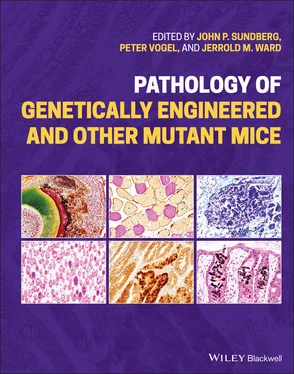| Gene |
Chromosome |
Position |
dbSNP |
Reference |
129P2/OlaHsd |
129S1/SvlmJ |
129S5SvEvBrd |
C3H/HeJ |
C57BL/6NJ |
DBA/2J |
KK/HiJ |
| 0610031O16Rik |
3 |
138,221,632 |
rs30512262 |
G |
C |
C |
C |
C |
‐ |
C |
C |
| 0610031O16Rik |
3 |
138,222,187 |
rs30594157 |
T |
C |
C |
C |
C |
‐ |
C |
C |
| 0610031O16Rik |
3 |
138,223,190 |
rs30907305 |
G |
A |
A |
A |
A |
‐ |
A |
A |
| 0610031O16Rik |
3 |
138,223,276 |
rs49048350 |
A |
T |
T |
T |
T |
‐ |
T |
T |
| 0610031O16Rik |
3 |
138,223,314 |
rs48657115 |
T |
G |
G |
G |
G |
‐ |
G |
G |
| 0610031O16Rik |
3 |
138,223,345 |
rs49621707 |
A |
T |
T |
T |
T |
‐ |
T |
T |
| 0610031O16Rik |
3 |
138,223,449 |
rs47855194 |
C |
T |
T |
T |
T |
‐ |
T |
T |
| 0610031O16Rik |
3 |
138,223,512 |
rs46440580 |
T |
C |
C |
C |
C |
‐ |
C |
C |
| Adh7 |
3 |
138,223,922 |
rs13468441 |
C |
T* |
T* |
T* |
T* |
‐ |
T* |
T* |
| 0610031O16Rik |
3 |
138,224,573 |
rs50005056 |
C |
T |
T |
T |
T |
‐ |
T |
T |
| 0610031I16Rik |
3 |
138,224,578 |
rs46271260 |
A |
G |
G |
G |
G |
‐ |
G |
G |
| 0610031O16Rik |
3 |
138,225,390 |
rs30170105 |
T |
C |
C |
C |
C |
‐ |
C |
C |
| 0610031O16Rik |
3 |
138,225,871 |
rs30695413 |
G |
A |
A |
A |
‐ |
‐ |
A |
A |
| 0610031O16Rik |
3 |
138,226,121 |
rs31386034 |
A |
C |
~ |
C |
C |
‐ |
~ |
~ |
| 0610031O16Rik |
3 |
138,226,125 |
rs31000950 |
C |
G |
G |
G |
G |
‐ |
G |
G |
| 0610031O16Rik |
3 |
138,226,160 |
rs30901573 |
G |
‐ |
‐ |
‐ |
A |
‐ |
‐ |
‐ |
| Adh7 |
3 |
138,226,410 |
rs31091615 |
A |
G* |
G* |
G* |
G* |
‐ |
G* |
G* |
| 0610031O16Rik |
3 |
138,228,417 |
rs30262949 |
T |
C |
C |
C |
C |
‐ |
C |
A |
| 0610031O16Rik |
3 |
138,228,503 |
rs50248152 |
G |
A |
A |
A |
A |
‐ |
A |
G |
| 0610031O16Rik |
3 |
138,228,653 |
rs31428790 |
A |
G |
G |
G |
G |
‐ |
G |
G |
| 0610031O16Rik |
3 |
138,228,722 |
rs30904366 |
A |
G |
G |
G |
G |
‐ |
G |
G |
| Adh7 |
3 |
138,231,370 |
‐ |
T |
g |
|
~ |
|
‐ |
|
|
| Adh7 |
3 |
138,231,388 |
rs50766077 |
C |
A |
A |
A |
A |
‐ |
A |
A |
| Adh7 |
3 |
138,231,410 |
rs46894990 |
A |
G |
G |
G |
G |
‐ |
G |
G |
| Adh7 |
3 |
138,231,427 |
rs46279078 |
T |
A |
A |
A |
A |
‐ |
A |
A |
Large Scale Mutagenesis
International Mouse Phenotyping Consortium (IMPC; https://www.mousephenotype.org)
Many pharmaceutical companies have created large number of mutant mice, some using large scale, high throughput methods to both create and phenotype the mice generated. However, their goals were very drug oriented and proprietary. Only now, many years later are some of the results becoming publicly available from such projects as those done by Lexicon [46]. An alternative approach was to systematically create null mutations in all known protein‐coding genes in the mouse and utilize a systematic and standardized phenotyping protocol. The International Mouse Phenotyping Consortium (IMPC) was developed to meet this objective [47]. While initially a variety of recombineering methods were used, now null mutations are created using CRISPR/Cas9. The goal is to inactivate approximately 20 000 genes one at a time on a standardized inbred strain (C56BL/6N). Attempts at overall standardization enable comparison of results creating in a sense an encyclopedia on gene function inferred from knockout phenotypes. However, there are variations between the environments at different participating institutions and different substrains of C57BL/6N are used. For example, some use a substrain where the Crb1 rd8allele causing a retinal phenotype in C57BL/6N mice was corrected using TALEN‐mediated homology‐directed repair [48]. This website provides deep summaries of the data by gene, together with primary data that is also accessible through the IMPC API web services. At the time of writing, 6440 knockouts have been phenotyped for more than 600 parameters in embryonic and adult life. A schematic of the phenotyping pipeline is shown in Figure 2.3.
Large numbers of radiographs and histopathology images are available on IMPC together with embryo images using different modes of imaging. Histopathology images are available on https://www.mousephenotype.org/data/landing_pages/histopathfor 580 genes and, where changes were diagnosed, use the combination of mouse pathology ontology (MPATH) and mouse anatomy ontology (MA) ontology terms as used in Pathbase ( Figure 2.4). Embryos, as part of the embryonic lethality program, are visualized using OPT, micro CT, and whole mounts, including LacZ expression reporters. Volumetric data are available from the micro CT and images through the dedicated embryo viewer ( https://www.mousephenotype.org/data/embryo_imaging). Radiographs were taken at week 14 and a standard set of orientations and organs displayed (see https://www.mousephenotype.org/impress/ProcedureInfo?action=list&procID=556).
The website is set up such that IMPC data can be used in a variety of ways, such as to investigate basic biology mechanisms that can lead to new therapeutic targets or to narrow down a suspected list of genes in patients. As with the Lexicon studies, the IMPC has and continues to make discoveries related to a wide variety of diseases [50–53].
MUTAGENETIX ( https://mutagenetix.utsouthwestern.edu)
MUTAGENETIX is a database of immunological phenotypes of single gene mouse mutants produced by ENU mutagenesis. It currently contains data generated by the Beutler Lab at the University of Texas Southwestern Medical Center and the Goodnow Lab at the Australian National University and provides access to strains maintained at these centers. The immunological data are very rich and the site contains information about protocols and breeding procedures that are very valuable. Note that incidental, nonimmunological phenotypes are also described for some mutations, such as growth, skin, and endocrine phenotypes. The site is updated regularly ( https://mutagenetix.utsouthwestern.edu) [54, 55].
Читать дальше












